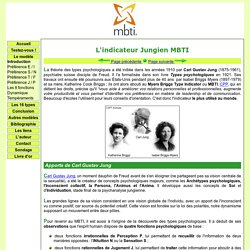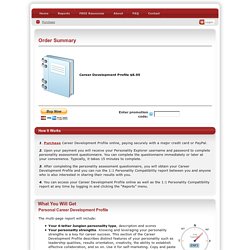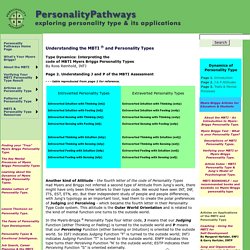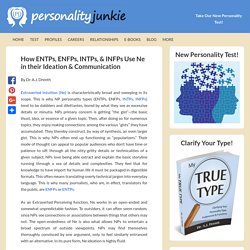

Le modele MBTI. Page précédente Page suivante La théorie des types psychologiques a été initiée dans les années 1910 par Carl Gustav Jung (1875-1961), psychiatre suisse disciple de Freud.

Il l'a formalisée dans son livre Types psychologiques en 1921. Ses travaux ont ensuite été poursuivis aux États-Unis pendant plus de 40 ans par Isabel Briggs Myers (1897-1979) et sa mère, Katherine Cook Briggs ; ils ont alors abouti au Myers Briggs Type Indicator ou MBTI. CPP, qui en détient les droits, précise qu'il “vous aide à améliorer vos relations personnelles et professionnelles, augmente votre productivité et vous permet d'identifier vos préférences en matière de leadership et de communication. Apports de Carl Gustav Jung Carl Gustav Jung, un moment dauphin de Freud avant de s'en éloigner (ne partageant pas sa vision centrale de la sexualité), a été le créateur de concepts psychologiques majeurs, comme les Archétypes psychologiques, l'Inconscient collectif, la Persona, l'Animus et l'Anima.
Purchase. Personal Career Development Profile The multi-page report will include: Your 4-letter Jungian personality type, description and scores Your personality strengths.

Knowing and leveraging your personality strengths is a key for career success. This section of the Career Development Profile describes distinct features of your personality such as leadership qualities, results orientation, creativity, the ability to establish effective collaboration, and so on. Use it for self-marketing. 1:1 Personality Compatibility Report You will be able to run 1:1 Personality Compatibility Report after completing the assessment questionnaire. Personality compatibility potential indicator Side-by-side comparison of your and the other person’s behavioural scores and personality radars Analysis, interpretation and tips on how to prevent potential and manage the existing tension and conflict between you and the other person. MBTI Personality Types. Another kind of Attitude - the fourth letter of the code of Personality Types Had Myers and Briggs not inferred a second type of Attitude from Jung's work, there might have only been three letters to their type code.

We would have seen INT, INF, ITS, EST, ETN, etc. But their independent study of people and people differences, with Jung's typology as an important tool, lead them to create the polar preferences of Judging and Perceiving - which became the fourth letter in their Personality Type Code system. This attitude is the Outer World Orientation and is related to the kind of mental function one turns to the outside world.
In the Myers-Briggs ® Personality Type four letter code, J means that our Judging Function (either Thinking or Feeling) is turned to the outside world and P means that our Perceiving Function (either Sensing or Intuition) is oriented to the outside world. For Extraverted Types, their dominant mental function determines their Outer World Orientation. More Function Posts. The Functions. There are two posts on personality theory that I recommend you start off with.

The first is an introduction to personality type theory and “the functional stack.” It explains, among other things, how we determine the four functions that make up each personality type’s functional stack. How ENTPs, ENFPs, INTPs, & INFPs Use Ne in their Ideation & Communication. By Dr.

A.J. Drenth. Relationships & Compatibility. ENFPs Archives. Enneagram, Myers-Briggs/MBTI, & the Inferior Function: Healthy Type Correlations. By Dr.

A.J. Drenth Having already explored common Myers-Briggs/MBTI and Enneagram correlations, in this post, I wished to incorporate the influential role of the inferior function into the equation. The inferior function seems to be a primary culprit in type ambivalence and misidentification. It also accounts for, among other things, many of the paradoxes we see in the personality types. Since the Myers-Briggs/MBTI and Enneagram are entirely different taxonomies, we should not expect perfect, one-to-one correlations between the types.
In the following analysis, I will describe what I feel are “healthy” and “less healthy” Enneagram/Myers-Briggs correlations. Enneagram 1 (One) Healthy Correlation: Myers-Briggs Judgers Less Healthy: Perceivers The One is often called “The Reformer.” The functional opposites of Te and Fe are Fi and Ti respectively. Enneagram 2 (Two) Healthy: Feelers Less Healthy: Thinkers Twos are “Helpers.” Enneagram 3 (Three)